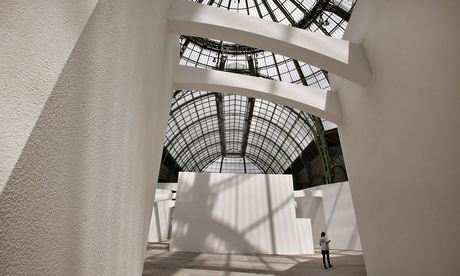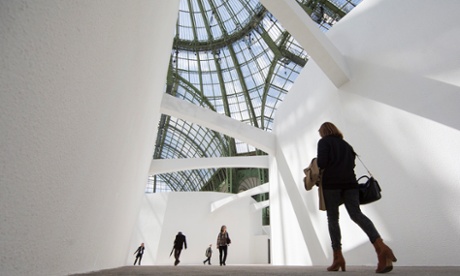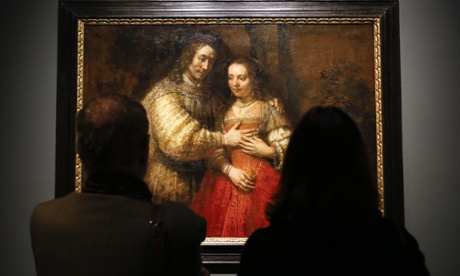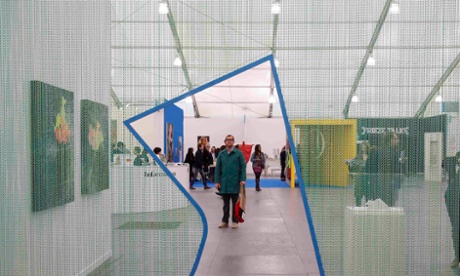At one end of the vast nave of the Grand Palais is something that looks like a radio telescope. The great raised dish points down the length of the building. Its bowl has echoes of both the belle epoque cupola in the roof, and 1950s Soviet-era space exploration. Alight with shifting colours, it emits calming mood-muzak, which seeps through the building with a drifting somnolence.
People under the device look tiny, even smaller than they usually do in this enormous crystal palace. And it is almost the best thing in Ilya and Emilia Kabakov's The Strange City, the latest in the Grand Palais' Monumenta series of commissions, which began in 2007. Richard Serra marched a series of steel slabs down the nave. Anish Kapoor filled the space with a giant inflatable. Monumenta invites grand, if not gargantuan, gestures. The Kabakovs have erected a group of seven eccentric buildings in a whitewashed medina that squats, blindingly white, in the centre of the space. A lone arch, like a sci-fi prop, stands between the city and the cupola-like dish.
The aesthetic harks back to Soviet dreams of a utopian future, though these buildings could belong anywhere, or nowhere at all but the mind of a film-set designer. They're not, however, as good as the amazing architectures Ken Adam designed for the early James Bond movies.
If the Strange City is the shape of things to come, it is also a future that didn't happen. Utopias never do. Born in Ukraine in 1933, Ilya Kabakov spent much of his career in Moscow, before emigrating to the west in 1987, where he married his niece Emilia, with whom he now collaborates. Much of his time in Moscow was spent illustrating children's books, and a certain childlike wonder informs his installations. Kabakov's early work had the feel of everyday Russian life. It was funny and touching and a bit sarcastic. At heart, he is a storyteller.
Each building in the Strange City contains a sprawling fiction. There's a Centre of Cosmic Energy, and another dedicated to meeting an angel – for which you need a ladder and a rucksack. Unlike the angel, which floats up by the ceiling, you might want to take a thermos and a change of underwear.
Another building is dedicated to ideas of the ideal city, and the next houses a gateway between life and death. I stood on both sides of the threshold and failed to detect any difference.
The Empty Museum, with its institutional doors that lead nowhere, is the simplest, and to my mind the best of the installations here. Bach's Passacaglia plays, and sconces illuminate the oxblood walls. You could imagine Soviet realist paintings that no one wants to look at hung here. Each of the other buildings house numerous intricate models, monuments to unknown religions and strange beliefs. There are lots of details children would like – stairs carved into mountains that spiral ever upward; weird labs built above the clouds; scaffolding of impossible height; volcano craters, towers of Babel, and little carved people everywhere that lend a sense of giddying scale.
Although the Strange City plays terrific games with scale, it fudges them. You easily forget you are already in a huge building that was itself once a vision of the future. Vast to the point of chronic obscurantism, and with heady doses of hocus pocus, it is easy to get lost among the details, never mind the nonsense behind it all: the noosphere and Rosenfeld's hypothesis, the idea that everything from the Egyptian pyramids to Tatlin's tower tilts at an angle of 60 degrees, and all sorts of playful theorising that is entirely the Kabakovs' own.
Like a multi-volume sci-fi fantasy, the Kabakovs aim to create a coherent, and entirely fabulated, universe. But their last two buildings bring us firmly back to Earth. Modelled on the Kabakov's Long Island studio, they house two groups of Ilya Kabakov's paintings. Enormous canvases fill the Dark Chapel, depicting the event at which the artists were presented with the Praemium Imperiale, an award given by the emperor of Japan. Interesting though these are, with their flipped perspectives, they don't have much to do with the Monumenta project, unless the Kabakovs view the Strange City as an autobiography as well as a fiction about the world.
The Strange City doesn't come off. Its relationship to the Grand Palais feels strained and strange. I like the big satellite dish, with its clunky yawning bowl. The city itself feels more like a retrospective, or a chance to revisit earlier installations. Strange or not, it could be anywhere.
• A-mazed and amused: Monumenta 2014's Strange City – in pictures










